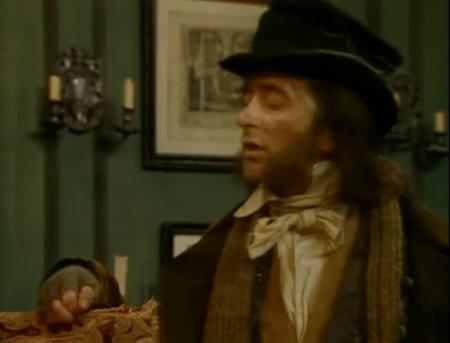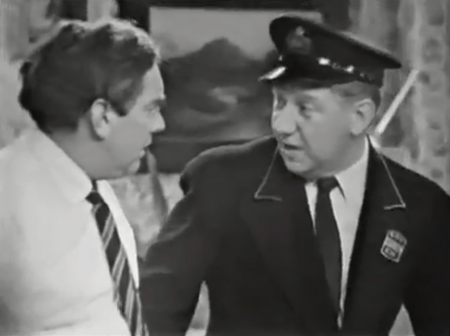Dear Mx Leeds and Mx Harvard,
I feel it only right to send this apology to you over the fact that previously on this blog I got a bit – um – disrespectful concerning the example given online of how to cite a television broadcast, i.e.:
I moaned about the fact that this wasn’t actually ‘Episode 16’ and I moaned even more about why somebody should have given the transmission date and time as ‘2009. Channel 4. 8 April, 22.00’ when to my mind the original transmission should have been ‘2009. ABC. 8 March, 21.00’. But that’s probably because I’m a moany sort of person and having a good moan about something gives a good start to the day… on the grounds that the day should get better after that.
And I probably shouldn’t have moaned. Because that citation was probably (or possibly) quite intentional. Previously, I explained how my database-mindset mind was quite happy to accept a ‘programme’/’broadcast date’ relationship as being one-to-many – i.e. one show has many broadcasts [i]. But maybe I need to revise my approach to how I structure that data, because it’s far more complex.
Now, my wife and I did watch Desperate Housewives (2004-2012) when it first aired in the UK and very much enjoyed it, but while we do remember as far as Betty Applewhite keeping a prisoner in her basement, I don’t think we got much beyond that. Certainly we never saw Captain Jack Harkness turn up. So I’m in no position to know if Desperate housewives, Episode 16, Crime doesn’t pay. 2009. ABC. 8 March, 21.00 and Desperate housewives, Episode 16, Crime doesn’t pay. 2009. Channel 4. 8 April, 22.00. were in fact exactly the same programme. Which they probably were.
Blackadder’s Christmas Carol. 1988. BBC1. 23 December, 21.30 and Blackadder’s Christmas Carol. 1989. BBC1. 26 December, 21.30 weren’t the same programme. Well, around 99% of them were the same, but in the latter you wouldn’t have experienced the following exchange which was present in the former. It comes after Baldrick has explained to Blackadder about the behaviour of the dog cast as Jesus in a nativity play.
BLACKADDER: Weren’t the children upset?
BALDRICK: Nah – they loved it. They want us to do another one at Easter. They want to see us nail up the dog.
As if having to navigate the choppy waters of pre-1980s regionalised ITV broadcasts isn’t bad enough, it’s even trickier when you realise that there can be more than one version of a programme… and that what you’ve seen on your particular transmission may not be what other people saw on a different broadcast. As such, the Leeds-Harvard notation is immensely useful for citing a specific broadcast of an individual programme, rather than just the programme itself.
And other broadcast dates are available. Lots of them. Enough to send you blind.
So what’s clearly happened with Blackadder’s Christmas Carol is that something on an original broadcast has been removed, most likely because of either complaints hinting at offence through blasphemy or the broadcaster being aware that the lines could give offence.
Possibly, there had been a change in society’s attitudes. As somebody who studies an awful amount of archival television, I now accept that the bulk of it somewhere along the line will be potentially offensive because of homophobic/racist/sexist/whatever content and that it was made in The Past and now we live in The Present we’re hopefully better people and will be even better people in The Future, and that The Past may not just have stopped at the end of the 1970s – it was probably still going on yesterday.
When it comes to Minder (1979-1994), Gunfight at the OK Laundrette. 1979. ITV. 29 October, 21.00 and Gunfight at the OK Laundrette. 1994. ITV. 17 March, 20.30 were also two slightly different programmes – one post-watershed and one pre-watershed. Although originally conceived as a rather raw slice of London low-life drama, the tone of the series had become increasingly comedic across the years. From 1993 it shifted from its traditional 9pm network slot to 8.30pm. And when it concluded its run in 1994, ITV asked its star George Cole to select his favourite episode as a sign-off. When George couldn’t pick from the plethora of riches, the broadcaster decided to go with the show which had kicked off the series 15 years earlier… and which regrettably featured in its opening minutes a sequence set in a strip club in which a lady exposed her upper body. 11 seconds of offending material was removed and replaced by 4 seconds from earlier in the sequence before the divestment occurred.
But sometimes broadcasts vary in other ways.
On the evening of 26 May 1961, actor Victor Platt recorded a sitcom appearance as a postman in what was being referred to as Hancock No 2. Not a big role… eight lines in all with the Lad Himself as he delivered Tony Hancock’s mail in an episode which spoofed production on a radio soap not unlike The Archers (1950-). Unfortunately, BBC TV was keen to stick to a strict 25 minute slot for transmission on 2 June, and when the videotape was edited down to 24’56” one of the cuts was Victor’s scene. Naturally, the actor was paid for his performance, but informed that since he was no longer in the programme, he would not receive any repeat fees. Which Victor quite understood…
However, in February 1969, Victor wrote to the BBC. Could he please have his repeat fee for The Bowmans (which was how this episode of Hancock (1961) had been referred to since its August 1961 repeat but hadn’t been referred to at the time of production)? No – said the BBC – you can’t, because you were edited out of that episode. Yes – said Victor – I agree that I wasn’t in that episode in June 1961, or in August 1961, or in March 1966, but I was in it when it was shown the other day as part of the tribute to the late Tony Hancock and I’d like my repeat fee please…
What had happened since 1966 was that the BBC had apparently wiped its original videotapes of Hancock which they had broadcast in 1961. However, in 1961 the commercial arm of BBC Enterprises had taken 16mm film recordings for overseas sale (to territories such as Australia) and these had come from the uncut pre-broadcast tapes. As such, transmissions such as The Bowmans. 1962. ABV-2, 26 April, 19.30 had included Victor’s postman… and thus the character had now made its BBC debut some eight years later because The Bowmans. 1969. BBC1. 3 February, 21.55 had been longer than No 2. 1961. BBC tv. 20.00 by some 57 seconds.
Each anomaly which can be categorised not just by programme but by transmission tells a story. Sometimes it’s not a very interesting story. With The Prisoner (1967-1968), A, B and C. 1983. Channel 4. 3 October, 22.00 Is missing the end of one key sequence in comparison to A, B and C. 1967. ATV Midlands. 13 October, 19.30 simply because ITC provided a cut print. Sometimes it’s far more interesting. With Monty Python’s Flying Circus (1969-1972), Sex and Violence. 1970. BBC1. 25 August, 22.00 was different to Sex and Violence. 1969. BBC1. 12 October, 23.05 because David Frost didn’t want any more late night phone calls from strange people asking for cheese.
There’s lots more like this…, but I just wanted to write and say sorry that I was so sniffy, because a transmission date other than the original broadcast is a very valid thing to do if it tells a different story [ii].
Hope that this finds you both well and fully referenced with whichever dates you feel present you at your best and most representative.
All the best
Andrew
Andrew Pixley is a retired data developer. For the last 30 years he’s written about almost anything to do with television if people will pay him – and occasionally when they won’t. Oh, The Grave-Diggers. 1984. Channel 4. 13 November, 18.00 and The Gravediggers. 1995. Channel 4. 17 October, 18.00. That’s another one… but slightly different in nature. Maybe tell you about that another time…
FOOTNOTES:
[i] … so you’d have a relationship where in Table A (Programme) you have the data relating to the programme itself in terms of fields like series, episode identifier (these two forming a unique key), writers, director, cast, synopsis, production number, production dates and so on, and then in Table B (Broadcasts) you have the columns of series, episode identifier, broadcaster, date, time and instance for that broadcaster so that series, episode identifier, broadcaster and instance for that broadcaster combine to form a unique key, with the relationship between Tables A and B being the combined fields for series and episode identifier. So one programme in Table A can have one or more broadcasts in Table B.
[ii] So I think we now need an adjustment to the database. Possibly a third table, Table C (Programme Variation) fitting between Tables A and B; this would have fields such as series, episode identifier, version identifier (these three forming a unique identifier) and then details of the variations such as duration, etc. One programme in Table A can have one or more versions in Table C (linked via series/episode identifier), and then each of these versions can have one or more broadcasts in Table B (linked via series/episode identifier/version).









Another lovely and fascinating blog, Andrew. But I have to know – did Victor Platt eventually manage to get the repeat fees he was owed?
Rest assured – the paperwork trail suggests that he most certainly did! 🙂
I like a story with a happy ending…
All the best
Andrew